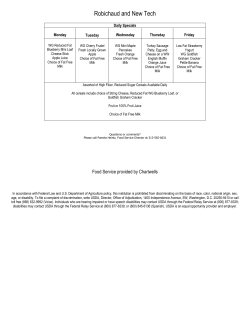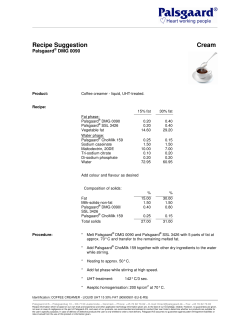
Chapter Four The Lipids: Fats & Oils
Chapter Four The Lipids: Fats & Oils NUT SCI 242 Food & Nutritional Health © Karen Lacey, MS ,RD, CD What are Lipids? A family of compounds that includes – Triglycerides (fats & oils) Fats: lipids that are solid at room temperature Oils: lipids that are liquid at room temperature – – Phospholipids Sterols (cholesterol). I. A Primer on Fats A. The Functions of Fat in the Body Energy source esp. for muscles Serves as an energy reserve 1# body fat contains 3500 kcal 30-50# of stored fat Cont’d Major component of cell membranes Nourishes skin & hair Insulates the body from temperature extremes Cushion the vital organs to protect them from shock B. The Functions of Fat in Food Provide calories (9 per gram) Provide satiety Carry fat-soluble vitamins & essential fatty acids Contribute aroma & flavor Lipid Terminology Triglycerides: the major class of dietary lipids, including fats & oils – Made up of 3 units known as fatty acids and 1 unit called glycerol (backbone) – Comprise about 95% of lipids in food and the human body Cont’d Phospholipids: – – 2nd of three main classes of lipids similar to a triglyceride, but contains phosphorous Sterols – – 3rd of three main classes of lipids; Cholesterol one of the sterols manufactured in the body for a variety of purposes Cont’d Fatty acids: – – basic units of fat composed of chains of carbon atoms an acid group at one end and hydrogen atoms attached all along their length II. A Closer View of Fats A. Chain Length (number of carbons linked together) B. Shorter = more soluble in water Saturated vs. Unsaturated (number of hydrogens the chain is holding) Maximum = saturated Unsaturated = one or more is missing Point of unsaturation = site where hydrogen is missing Cont’d Saturated fatty acid: a fatty acid carrying the maximum possible number of hydrogen atoms – Animal foods such as meat, poultry and fullfat dairy products – Tropical oils such as palm and coconut Cont’d Unsaturated fatty acid: a fatty acid with one or more points of unsaturation. – Found in foods from both plants & animal sources Monounsaturated fatty acids (one double bond) Polyunsaturated fatty acids (two or more) Cont’d Monounsaturated fatty acid: also called a MUFA; a fatty acid containing one point of unsaturation – Found mostly in vegetable oils such as olive, canola & peanut Cont’d Polyunsaturated fatty acids: also called a PUFA; a fatty acid in which two or more point of unsaturation occur – Found in nuts, vegetable oils such as safflower, sunflower and soybean, and in fatty fish B. Essential Fatty Acids The body can synthesize all of the fatty acids it needs from carbohydrates, fat or protein except for two: 1. Linoleic acid 2. Linolenic acid – PUFAs – Found in plant & fish oils Omega - 6 versus Omega - 3 Omega – 6 Linoleic Omega – 3 Linolenic Cold water fish Help dissolve blood clots Lower blood pressure Dilate the arteries III. Characteristics of Fats in Foods A. Liquid vs Solid More saturated a fat is, the more solid it is at room temperature More unsaturated a fat is, the more liquid it is at room temperature III. Characteristics of Fats in Foods A. Hydrogenation The process of adding hydrogen to unsaturated fat to make it more solid and more resistant to chemical changes such as spoiling Increasing a fat’s saturation can cause a fat to lose its unsaturated health benefits C. Trans-Fatty Acids Formed when margarine is processed Hydrogen molecules are on opposite sides of point of unsaturation “Partially hydrogenated vegetable oil” Link between trans fatty acids and heart disease Table 4-3, page 107 Keep to minimum V. Phospholipids A lipid consisting of a water-soluble head and a fat-soluble tail Contain phosphorous Component of cell membranes Serve as emulsifiers (allow fats and water to mix and travel in and out of cells into watery fluid on both sides) Cont’d Lecithin is a common phospholipid – Often used as an emulsifier in foods such as margarine, chocolate & salad dressings V. Cholesterol – a Sterol Found only in animal products Also made & used in the body: – Structure of cell membranes – Used to make bile for digestion Bile: a mixture of compounds, made by the liver, stored in the gallbladder, & secreted into the small intestine Emulsifies lipids to prepare them for enzymatic digestion & helps transport them into the intestinal wall cells Cont’d Used to make the sex hormones estrogen & testosterone Made into vitamin D with the help of sunlight Deposited in the artery walls leading to plaque buildup & heart disease VI. How the Body Handles Fat A. B. C. Digestion Emulsification Absorption VII. Lipids & Health A. B. C. D. Good vs. Bad Cholesterol http://www.americanheart.org/ http://www.mayohealth.org/ http://www.fda.gov/ B. Lowering Blood Cholesterol Levels Eat no more than 30% of calories from fat Eat no more than 8-10% of calories from saturated fat Eat no more than 10% of calories from PUFAs MUFAs should make up 10-15% of total calories Limit daily cholesterol intake to no more than 300 milligrams VIII. Fat in the Diet A. Food Guide Pyramid 3 groups traditionally account for nine-tenths of the fat in the U.S. diet Fats, oils & sweets group Meat, poultry, fish, dry beans, eggs & nut group Milk, yogurt & cheese group Most of the fat in our diets comes from animal products B. Fat Substitutes Carbohydrate-based – – Help retain moisture to maintain the juiciness or creaminess that is lost with fat reduction Carrageenan, fruit purees, gelatin, gums, starches & products made from fiber Protein-based – – Proteins are cooked & blended to form tiny round particles that trap water to maintain the mouth feel of fat Whey protein concentrate (Dairy-Lo), or milk & egg white protein (Simplesse) Cont’d Fat-based – Are either only partially digestible or completely undigestible to prevent absorption of fat – Caprenin (substitute for cocoa butter in candy), Salatrim (found in low fat baking chips), and olestra (often found in fat free potato chips) C. At the Grocery Store Read labels to determine both the amounts & types of fat contained in foods D. In the Kitchen Use canola & olive oil for baking & cooking Prepare lean cuts of meat Bake, broil & steam instead of frying Use low-fat or fat-free dairy products & dressings Season with herbs & spices rather than with fats Incorporate plant-based protein sources such as soy & legumes E. At the Table Eat more fresh fruits & vegetables Use jam instead of butter Limit use of high-fat condiments including mayo, butter & sour cream or use low-fat varieties Use mostly monounsaturated vegetable oils such as olive or canola Eat fewer high-fat desserts F. Recipe Modification Egg whites Fat-free evaporated milk Fat-free sour cream Fruit purees Fat-free cream cheese Oils IX. Diet & Heart Disease A. Risk Factors High cholesterol High blood pressure Smoking Diabetes Lack of exercise Stress Obesity Unhealthy diet Age Gender Genetics Cont’d B. Ways to Reduce Risk Limit intake of cholesterol & saturated fat Quit smoking Maintain a healthy weight Eat high fiber foods Increase physical activity Increase fruit & vegetable consumption Limit alcohol consumption
© Copyright 2025

















